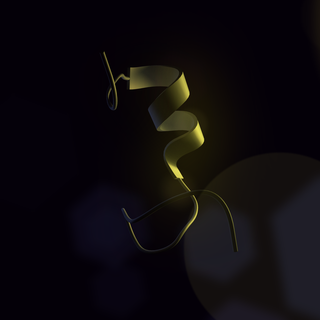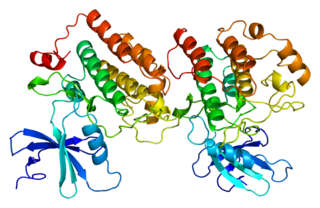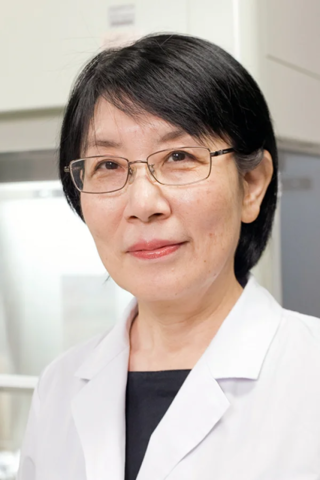PER2 is a protein in mammals encoded by the PER2 gene. PER2 is noted for its major role in circadian rhythms. [5] [6]
PER2 is a protein in mammals encoded by the PER2 gene. PER2 is noted for its major role in circadian rhythms. [5] [6]
The per genewas first discovered using forward genetics in Drosophilla melanogaster in 1971. Mammalian Per2 was discovered by in 1997 through a search for homologous cDNA sequences to PER1. [7] It is more similar to Drosophila per than its paralogs. [8] Later experiments in also identified Per2 in humans.
PER2 is a member of the Period family of genes and is expressed in a circadian pattern in the suprachiasmatic nucleus, the primary circadian pacemaker in the mammalian brain. Genes in this family encode components of the circadian clock, which regulates the daily rhythms of locomotor activity, metabolism, and behavior. Circadian expression of these genes and their encoded proteins in the suprachiasmatic nucleus. Human PER2 is involved in human sleep disorder and cancer formation. [9] Lowered PER2 expression is common in many tumors cells within the body, suggesting PER2 is integral for proper function and decreased levels promotes tumor progression. [10] [11]
PER2 contains glucocorticoid response elements (GREs) and a GRE within the core clock gene PER2 is continuously occupied during rhythmic expression and essential for glucocorticoid regulation of PER2 in vivo. Mice with a genomic deletion spanning this GRE expressed elevated leptin levels and were protected from glucose intolerance and insulin resistance on glucocorticoid treatment but not from muscle wasting. PER2 is an integral component of a particular glucocorticoid regulatory pathway and that glucocorticoid regulation of the peripheral clock is selectively required for some actions of glucocorticoids. [12]
PER2 expression in mice is increased by exposure to 13000 lumens of intense daylight such as Sunshine while decreasing Troponin levels in equal opposite amounts. PER2 in turn enhances oxygen-efficient glycolysis and hence provides cardioprotection from ischemia. Therefore, it is speculated that strong light may reduce the risk of heart attacks and decrease the damage after experiencing one. [13] Moreover, PER2 has protective functions in liver diseases, as it antagonizes hepatitis C viral replication. [14]
Per2 knockout mice experience a free-running period of around 21.8 hours, compared to the normal mouse free-running period of 23.3 hours. Some of the Per2 knockout mice can also become arrhythmic under constant light conditions. PER2 has also been shown to be possibly important in the development of cancer. PER2 expression is significantly lower in human patients with lymphoma and acute myeloid leukemia. [15]
The PER2 protein seems to be important for the proliferation of osteoblasts, which aid in adding density to the bone through a pathway utilizing Myc and Ccnd1. Certain PER2 mutations have shown that they can increase the tolerance to the amount of alcohol that a mouse can intake through reduced uptake of glutamate. [16]
In mammals, mPER2 forms a heterodimer with mPER1, mCRY1, and mCRY2 by binding to PAS domains. The heterodimer acts to inhibit their own transcription by suppressing the CLOCK/BMAL1 complex resulting in a negative feedback loop. [17] [18] This negative feedback loop is essential for maintaining a functioning circadian clock. A disruption of either both mPER1 and mPER2 genes together or both mCRY genes causes behavioural arrhythmicity when the double-knockout animals are placed in constant conditions. A third PER gene, mPer3, does not have a critical role in the maintenance of the core clock feedback loops. Molecular and behavioural rhythms are preserved in mice lacking mPer3. [19]
PER2 has been shown to interact with a kinase called CK1e. CK1e phosphorylates PER2 in mammals. In Syrian hamster, a mutation called tau has been discovered in the CK1e, which increases phosphorylation of homologous PER2 leading to a faster degradation and a shortened period. [20] Mutations in hPER2 can cause FASPS because of a lack of phosphorylation site in the mutated hPER2 protein.
| Peak of mRNA | Peak of Protein | Protein Motifs | PER1, PER3 | PER1, CRY1, CRY2 | PER2 binding to Clock/Bmal1 | CK1E | |
|---|---|---|---|---|---|---|---|
| PER2 | ZT 6 | ZT 12 | PAS domain | Binds together through PAS domain | Forms heterodimer to inhibit Clock/Bmal1 | PER2 inhibits its own transcription through inhibition of Clock/Bmal1. | Phosphorylates PER2 |
A genetic test from a cheek swab can use PER2 expression levels to tell whether a person is an early morning person or a "night owl". [21]
Familial advanced sleep phase (FASP) is characterized as a short period (e.g. 23.3 vs 24.3hr for population) in humans. A mutation in hPER2 decreases its phosphorylation by CK1d, which causes the phenotype seen in some FASP. [22] The primary cause of these FASP is a mutation that changes amino acid 662 from serine to glycine (S662G) in PER2. The S662G mutation makes PER2 mutant protein a stronger repressor than normal PER2, decreasing cellular PER2 levels and therefore causing this form of FASP. The mutation also seems to cause an increase in the turnover rate of PER2 in the nucleus. [16]
The PER2 gene is located on the long (q) arm of chromosome 2 at position 37.3 and has 25 exons. [9]
Predicted human PER2 protein created from the PER2 gene shares 44% identity with human PER1 and 77% identity with mouse Per2. Northern blots analysis revealed that PER2 was expressed as a 7-kb mRNA in all tissues examined. An additional 1.8-kb transcript was also detected in some tissues. [23] PER2 mRNA has been shown to peak at ZT 6 in the SCN. [16]
Advanced Sleep Phase Disorder (ASPD), also known as the advanced sleep-phase type (ASPT) of circadian rhythm sleep disorder, is a condition that is characterized by a recurrent pattern of early evening sleepiness and very early morning awakening. This sleep phase advancement can interfere with daily social and work schedules, and results in shortened sleep duration and excessive daytime sleepiness. The timing of sleep and melatonin levels are regulated by the body's central circadian clock, which is located in the suprachiasmatic nucleus in the hypothalamus.

The suprachiasmatic nucleus or nuclei (SCN) is a small region of the brain in the hypothalamus, situated directly above the optic chiasm. The SCN is the principal circadian pacemaker in mammals, responsible for generating circadian rhythms. Reception of light inputs from photosensitive retinal ganglion cells allow the SCN to coordinate the subordinate cellular clocks of the body and entrain to the environment. The neuronal and hormonal activities it generates regulate many different body functions in an approximately 24-hour cycle.

CREB-TF is a cellular transcription factor. It binds to certain DNA sequences called cAMP response elements (CRE), thereby increasing or decreasing the transcription of the genes. CREB was first described in 1987 as a cAMP-responsive transcription factor regulating the somatostatin gene.
The Casein kinase 1 family of protein kinases are serine/threonine-selective enzymes that function as regulators of signal transduction pathways in most eukaryotic cell types. CK1 isoforms are involved in Wnt signaling, circadian rhythms, nucleo-cytoplasmic shuttling of transcription factors, DNA repair, and DNA transcription.

CLOCK is a gene encoding a basic helix-loop-helix-PAS transcription factor that is known to affect both the persistence and period of circadian rhythms.
Timeless (tim) is a gene in multiple species but is most notable for its role in Drosophila for encoding TIM, an essential protein that regulates circadian rhythm. Timeless mRNA and protein oscillate rhythmically with time as part of a transcription-translation negative feedback loop involving the period (per) gene and its protein.
Period (per) is a gene located on the X chromosome of Drosophila melanogaster. Oscillations in levels of both per transcript and its corresponding protein PER have a period of approximately 24 hours and together play a central role in the molecular mechanism of the Drosophila biological clock driving circadian rhythms in eclosion and locomotor activity. Mutations in the per gene can shorten (perS), lengthen (perL), and even abolish (per0) the period of the circadian rhythm.

Neuronal PAS domain protein 2 (NPAS2) also known as member of PAS protein 4 (MOP4) is a transcription factor protein that in humans is encoded by the NPAS2 gene. NPAS2 is paralogous to CLOCK, and both are key proteins involved in the maintenance of circadian rhythms in mammals. In the brain, NPAS2 functions as a generator and maintainer of mammalian circadian rhythms. More specifically, NPAS2 is an activator of transcription and translation of core clock and clock-controlled genes through its role in a negative feedback loop in the suprachiasmatic nucleus (SCN), the brain region responsible for the control of circadian rhythms.

The PER3 gene encodes the period circadian protein homolog 3 protein in humans. PER3 is a paralog to the PER1 and PER2 genes. It is a circadian gene associated with delayed sleep phase syndrome in humans.

FBXL3 is a gene in humans and mice that encodes the F-box/LRR-repeat protein 3 (FBXL3). FBXL3 is a member of the F-box protein family, which constitutes one of the four subunits in the SCF ubiquitin ligase complex.

Aryl hydrocarbon receptor nuclear translocator-like 2, also known as Arntl2, Mop9, Bmal2, or Clif, is a gene.

Period circadian protein homolog 1 is a protein in humans that is encoded by the PER1 gene.
In molecular biology, an oscillating gene is a gene that is expressed in a rhythmic pattern or in periodic cycles. Oscillating genes are usually circadian and can be identified by periodic changes in the state of an organism. Circadian rhythms, controlled by oscillating genes, have a period of approximately 24 hours. For example, plant leaves opening and closing at different times of the day or the sleep-wake schedule of animals can all include circadian rhythms. Other periods are also possible, such as 29.5 days resulting from circalunar rhythms or 12.4 hours resulting from circatidal rhythms. Oscillating genes include both core clock component genes and output genes. A core clock component gene is a gene necessary for to the pacemaker. However, an output oscillating gene, such as the AVP gene, is rhythmic but not necessary to the pacemaker.
Joseph S. Takahashi is a Japanese American neurobiologist and geneticist. Takahashi is a professor at University of Texas Southwestern Medical Center as well as an investigator at the Howard Hughes Medical Institute. Takahashi's research group discovered the genetic basis for the mammalian circadian clock in 1994 and identified the Clock gene in 1997. Takahashi was elected to the National Academy of Sciences in 2003.
Steven M. Reppert is an American neuroscientist known for his contributions to the fields of chronobiology and neuroethology. His research has focused primarily on the physiological, cellular, and molecular basis of circadian rhythms in mammals and more recently on the navigational mechanisms of migratory monarch butterflies. He was the Higgins Family Professor of Neuroscience at the University of Massachusetts Medical School from 2001 to 2017, and from 2001 to 2013 was the founding chair of the Department of Neurobiology. Reppert stepped down as chair in 2014. He is currently distinguished professor emeritus of neurobiology.

Casein kinase I isoform epsilon or CK1ε, is an enzyme that is encoded by the CSNK1E gene in humans. It is the mammalian homolog of doubletime. CK1ε is a serine/threonine protein kinase and is very highly conserved; therefore, this kinase is very similar to other members of the casein kinase 1 family, of which there are seven mammalian isoforms. CK1ε is most similar to CK1δ in structure and function as the two enzymes maintain a high sequence similarity on their regulatory C-terminal and catalytic domains. This gene is a major component of the mammalian oscillator which controls cellular circadian rhythms. CK1ε has also been implicated in modulating various human health issues such as cancer, neurodegenerative diseases, and diabetes.
Hitoshi Okamura is a Japanese scientist who specializes in chronobiology. He is currently a professor of Systems Biology at Kyoto University Graduate School of Pharmaceutical Sciences and the Research Director of the Japan Science Technology Institute, CREST. Okamura's research group cloned mammalian Period genes, visualized clock oscillation at the single cell level in the central clock of the SCN, and proposed a time-signal neuronal pathway to the adrenal gland. He received a Medal of Honor with Purple Ribbon in 2007 for his research and was awarded Aschoff's Ruler for his work on circadian rhythms in rodents. His lab recently revealed the effects of m6A mRNA methylation on the circadian clock, neuronal communications in jet lag, and the role of dysregulated clocks in salt-induced hypertension.
Hajime Tei is a Japanese neuroscientist specializing in the study of chronobiology. He currently serves as a professor at the Kanazawa University Graduate School of Natural Science & Technology. He is most notable for his contributions to the discovery of the mammalian period genes, which he discovered alongside Yoshiyuki Sakaki and Hitoshi Okamura.

Sato Honma is a Japanese chronobiologist who researches the biological mechanisms of circadian rhythms. She mainly collaborates with Ken-Ichi Honma on publications, and both of their primary research focuses are the human circadian clock under temporal isolation and the mammalian suprachiasmatic nucleus (SCN), its components, and associates. Honma is a retired professor at the Hokkaido University School of Medicine in Sapporo, Japan. She received her Ph.D. in physiology from Hokkaido University. She taught physiology at the School of Medicine and then at the Research and Education Center for Brain Science at Hokkaido University. She is currently the director at the Center for Sleep and Circadian Rhythm Disorders at Sapporo Hanazono Hospital and works as a somnologist.
Familial sleep traits are heritable variations in sleep patterns, resulting in abnormal sleep-wake times and/or abnormal sleep length.
This article incorporates text from the United States National Library of Medicine, which is in the public domain.